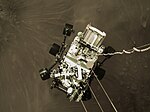astro.wikisort.org - Asteroid
2021 UA1 is a small (~2 meter) near-Earth object that passed about 3047 km from the surface of Earth while passing over Antarctica on 25 October 2021 around 03:07 UT.[5][lower-alpha 1] Given the small size of the asteroid it only reached the brightness of Pluto at around apparent magnitude 14.[5] Since it approached from the direction of the Sun, it was not discovered until 4 hours after closest approach.[1]
| Asteroid | Date | Distance from surface of Earth |
Uncertainty in approach distance |
Reference |
|---|---|---|---|---|
| 2020 VT4 | 2020-11-13 | 374 km | ±25 km | data |
| 2020 QG | 2020-08-16 | 2946 km | ±20 km | data |
| 2021 UA1 | 2021-10-25 | 3047 km | ±20 km | data |
| 2011 CQ1 | 2011-02-04 | 5481 km | ±5 km | data |
| 2019 UN13 | 2019-10-31 | 6242 km | ±200 km | data |
| 2008 TS26 | 2008-10-09 | 6259 km | ±1000 km | data |
| 2004 FU162 | 2004-03-31 | 6542 km | ±15000 km | data |
 Orbit of 2021 UA1 | |
| Discovery[1] | |
|---|---|
| Discovered by | Catalina Sky Survey |
| Discovery date | 25 October 2021 |
| Designations | |
MPC designation | 2021 UA1 |
Minor planet category |
|
| Orbital characteristics[3] | |
| Epoch 2021-Jul-01 (JD 2459396.5) | |
| Uncertainty parameter 6 | |
| Observation arc | 0.9 days[2] |
| Aphelion | 1.35 AU (Q) |
| Perihelion | 0.6139 AU (q) |
Semi-major axis | 0.98 AU (a) |
| Eccentricity | 0.3750 (e) |
Orbital period (sidereal) | 0.97 years |
Mean anomaly | 312.8° (M) |
| Inclination | 10.19° (i) |
Longitude of ascending node | 211.6° (Ω) |
Argument of perihelion | 66.27° (ω) |
| Earth MOID | 0.000064 AU (9,600 km) |
| Jupiter MOID | 3.7 AU (550,000,000 km) |
| Physical characteristics | |
| Dimensions |
|
Absolute magnitude (H) | 31.8[3][4] |
The 2021 Earth approach lifted the orbit and increased the orbital period from 356 days to 413 days.[6] This changed it from an Aten asteroid to an Apollo asteroid.
| Parameter | Epoch | Period (p) |
Aphelion (Q) |
Perihelion (q) |
Semi-major axis (a) |
Eccentricity (e) |
Inclination (i) |
|---|---|---|---|---|---|---|---|
| Units | (days) | AU | (°) | ||||
| Pre-flyby | 2021-Jul-01[3] | 355.6 | 1.351 | 0.614 | 0.982 | 0.3750 | 10.19° |
| Post-flyby | 2022-Jan-01[6] | 413.1 | 1.525 | 0.646 | 1.086 | 0.4046 | 0.006° |

2021 UA1 · Mercury · Venus · Earth · Mars · Sun
Notes
- Geocentric approach distance 0.000063 AU – 6378 km (Earth radius) is 3047 km. It passed within 4 degrees of the South celestial pole near closest approach.
References
- "MPEC 2021-U95 : 2021 UA1". IAU Minor Planet Center. 26 October 2021. Retrieved 26 October 2021. (K21U01A)
- "Earth Impact Risk Summary: 2021 UA1". NASA/JPL Near-Earth Object Program Office. Retrieved 26 October 2021.
- "JPL Small-Body Database Browser: (2021 UA1)" (Under Close Approach Data select km for distance units). Jet Propulsion Laboratory. Retrieved 26 October 2021.
- "2021 UA1 Orbit". Minor Planet Center. Retrieved 26 October 2021.
- "Horizons Batch for 2021-10-25 03:06 UT". JPL Horizons. Archived from the original on 26 October 2021. Retrieved 26 October 2021.
- "Horizons Batch showing epoch 2021-Jul-01 and 2022-Jan-01". JPL Horizons. Retrieved 26 October 2021.
External links
- 2021 UA1 Close approach date: 2021 10 25.130000 (03 07 12.0) – MPC diagram using WebGL
- 2021 UA1 – Tony Dunn (Gravity Simulator)
- 2021 UA1 – David Rankin (Catalina Sky Survey)
- 2021 UA1 at NeoDyS-2, Near Earth Objects—Dynamic Site
- Ephemeris · Obs prediction · Orbital info · MOID · Proper elements · Obs info · Close · Physical info · NEOCC
- 2021 UA1 at ESA–space situational awareness
- 2021 UA1 at the JPL Small-Body Database
Текст в блоке "Читать" взят с сайта "Википедия" и доступен по лицензии Creative Commons Attribution-ShareAlike; в отдельных случаях могут действовать дополнительные условия.
Другой контент может иметь иную лицензию. Перед использованием материалов сайта WikiSort.org внимательно изучите правила лицензирования конкретных элементов наполнения сайта.
Другой контент может иметь иную лицензию. Перед использованием материалов сайта WikiSort.org внимательно изучите правила лицензирования конкретных элементов наполнения сайта.
2019-2025
WikiSort.org - проект по пересортировке и дополнению контента Википедии
WikiSort.org - проект по пересортировке и дополнению контента Википедии


